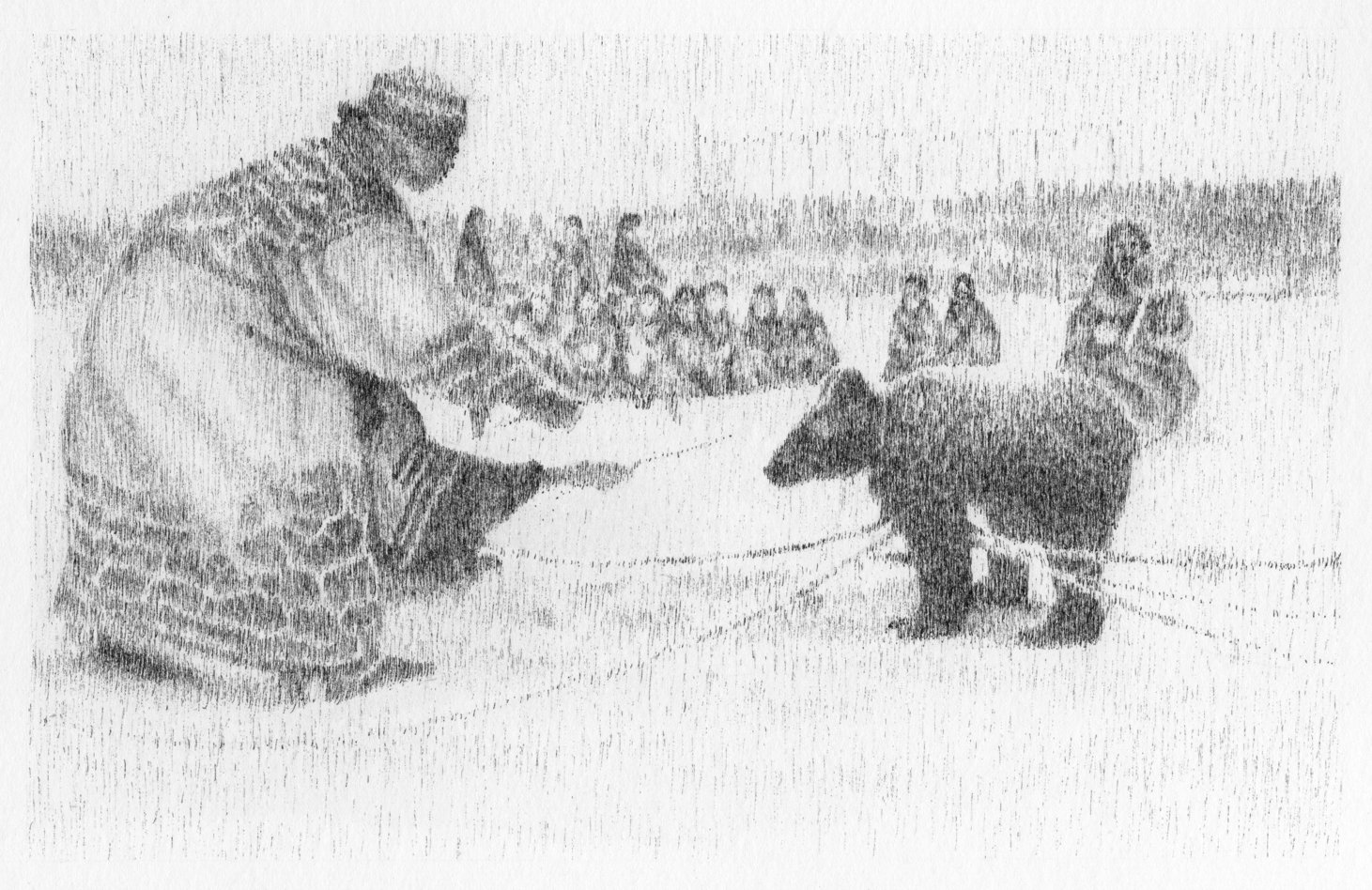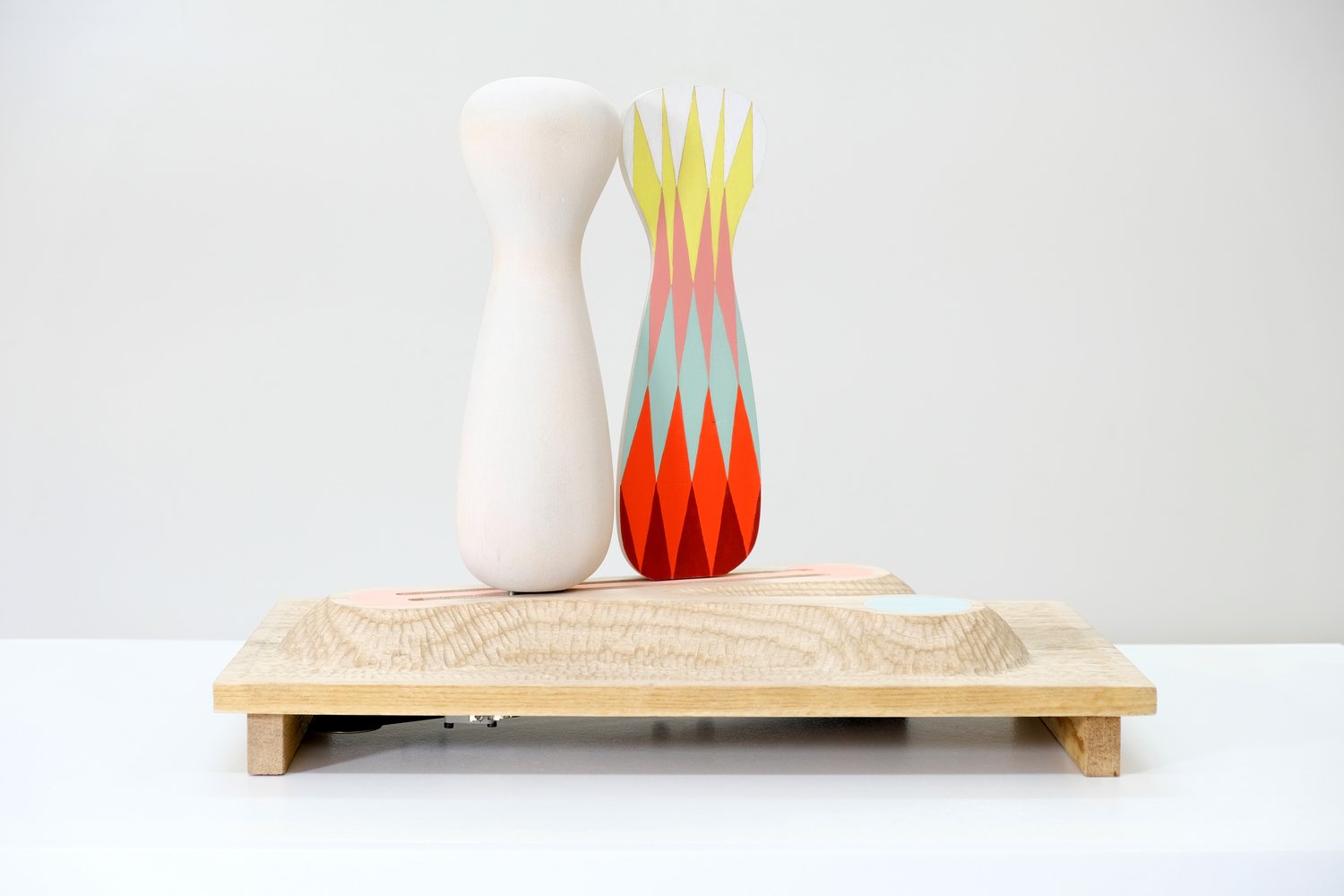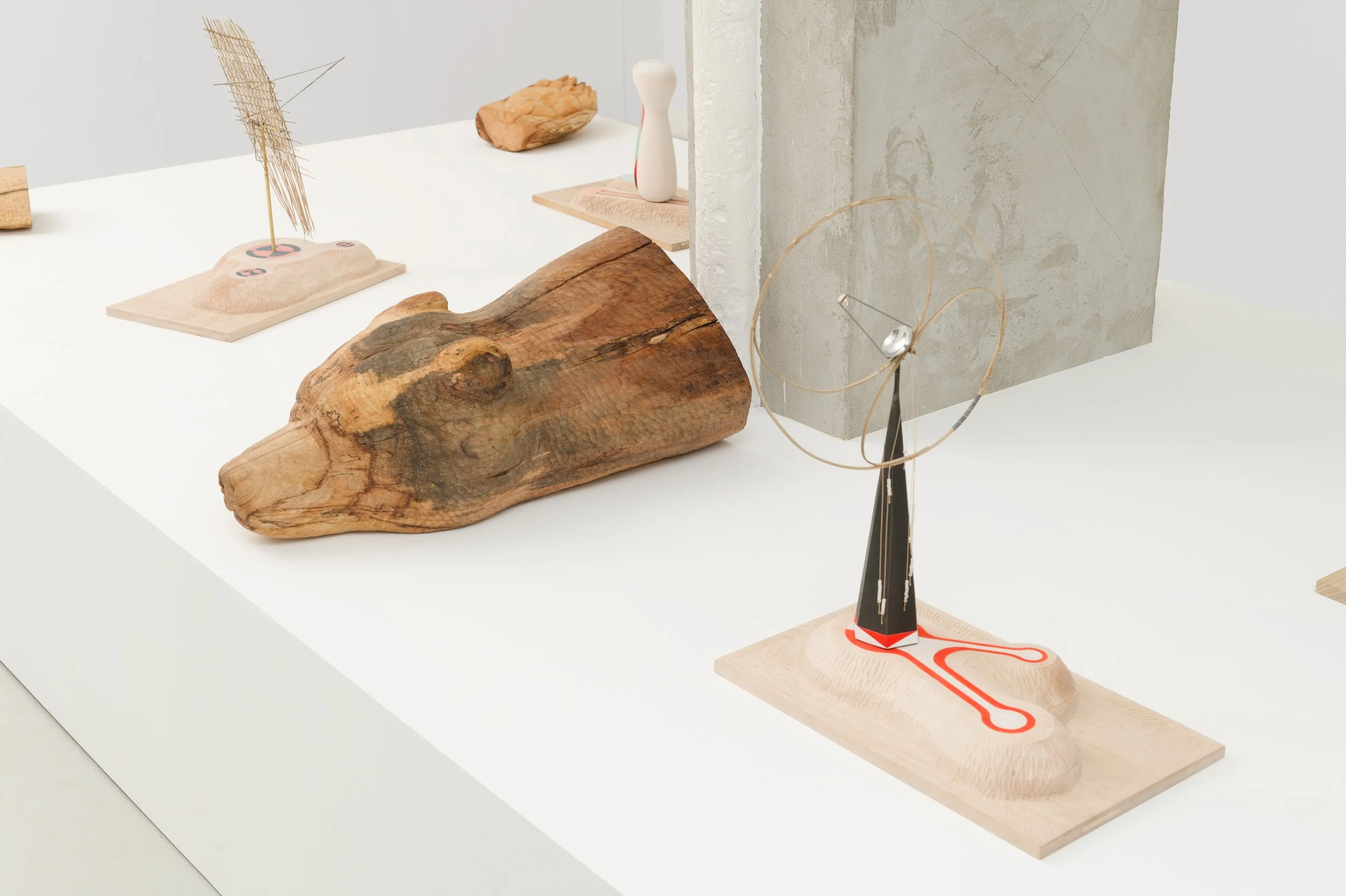“Nicolas Darrot”
….
« Les hommes ne savent pas comment ce qui varie est d’accord avec soi. Il y a une harmonie de tensions opposées comme celle de l’arc et de la lyre. »
Héraclite, fragments.
Il a l’air endormi. La tête posée à même le sol, un ours s’étend dans la Galerie. De son corps, on ne distingue que les pattes –taillées sur bois à la gouge par l’artiste –et les yeux clos de sa face lui confèrent un air apaisé. On s’approche et l’interrogation surgit : dort-il vraiment ? Et qu’est-il arrivé au reste de son corps, dont l’absence laisse place à d'autres objets ? Entourant la colonne de la galerie, ses membres –tels des points cardinaux –sont autant de repères nécessaires à notre regard, d’étapes permettant la compréhension de l’œuvre de Nicolas Darrot. À la manière de l’illustre astérisme, cette grande ourse agit en table d’orientation : dans l'espace ouvert par la dispersion de ses membres s’épanouit une constellation de sculptures animées. Certaines observent un rythme cyclique (Kachina 1 et Kachina 2), quand d'autres suivent précisément la course d'un astre, solaire pour l'une, et stellaire pour l’autre, qui est pointée sur la marche d'Alioth, étoile la plus brillante du grand chariot. Le corps de l'ours s'est, lui, subitement, mué en observatoire astronomique.
À cette géographie centrale répond, aux murs, une série de dessins évoquant des moments de la culture Aïnou. Ce peuple, natif du Hokkaïdo, île septentrionale de l'archipel Japonais, se trouve ici évoqué à la lisière du registre imaginaire à travers les étapes du Iomante, son rituel cardinal et aujourd'hui disparu. Commençant avec la capture d'un ourson qui était élevé durant plusieurs années par la communauté, l'Iomante culminait lors d’une cérémonie où l'animal était abattu au moyen de flèches, imbibées d'une préparation narcotique, tandis que l'esprit prisonnier du corps de l'ours était accompagné dans sa libération par un ensemble de chants et de danses collectifs.
Aux volutes sonores de cette cérémonie font écho les entrelacs complexes des motifs décoratifs Aïnous -que l’on retrouve notamment sur leur vêtements-, lesquels possèdent une fonction sémantique, permettant à chacun ainsi de se « vêtir du texte de sa vie ». Nicolas Darrot reprend ces agencements dans une large pièce murale (Aïnu moon) où ces motifs –tressés par l’artiste –orbitent, s’orientent et se déplacent selon le calendrier lunaire.
Aux côtés de cette révolution, dans la galerie, quatre flèches (Kushiro, Kutchan, Hiroo et Wakkanaï) renvoient aux quatre points cardinaux du Hokkaïdo. Leur pointe s'inspire formellement des flèches traditionnelles kabuto-ya et kabura-ya tirées lors des rituels Shinto visant à éloigner les démons d'une nouvelle architecture. Ces flèches sont associées aux données anémométriques (les relevés des vents) des quatre sites évoqués –et que l'artiste a recueillies –pour donner à chaque flèche l'orientation correspondant aux variations des vents au cours d'une année.
Ces flèches tracent et pointent sans cesse vers le corps de la Grande Ourse. Tout juste infléchies par les vents terrestres elles sont des vecteurs qui définissent et balisent l'espace de l'exposition. Celui-ci devient alors un ensemble, un tout, un cosmos à la manière de ce que produisait le rituel Iomante. Dans ce grand tout, la constellation de sculptures de l’exposition suit un régime de mouvements immobiles, semblable à la dérive des étoiles.
Télécharger le dossier d’exposition : ici
Site de l’artiste: https://nicolasdarrot.com/
..
"Men do not know how that which varies agrees with itself. There is a harmony of opposing tensions like that of the bow and the lyre."
Heraclitus, fragments.
He looks asleep. With his head resting on the ground, a bear lies in the Gallery. All that can be seen of its body are its paws - carved on wood with a gouge by the artist - and the closed eyes on its face give it an air of calm. As you approach, the question arises: is he really asleep? And what has happened to the rest of his body, whose absence leaves room for other objects? Surrounding the gallery column, his limbs - like points of the compass - serve as landmarks for our gaze, stages in the understanding of Nicolas Darrot's work. Like the illustrious asterism, this great bear acts as an orientation table: in the space opened up by the dispersal of its limbs, a constellation of animated sculptures flourishes. Some follow a cyclical rhythm (Kachina 1 and Kachina 2), while others precisely follow the course of a star, one solar, the other stellar, which is pointed at the step of Alioth, the brightest star in the great chariot. The bear's body has suddenly become an astronomical observatory.
This central geography is echoed on the walls by a series of drawings evoking moments in Ainu culture. This people, native to Hokkaido, the northern island of the Japanese archipelago, are evoked here at the edge of the imaginary register through the stages of the Iomante, their cardinal ritual, which has now disappeared. Beginning with the capture of a bear cub that was raised for several years by the community, the Iomante culminated in a ceremony in which the animal was shot with arrows soaked in a narcotic preparation, while the spirit imprisoned in the bear's body was accompanied in its liberation by a group of songs and dances.
The swirling sounds of this ceremony are echoed in the complex interlacing of Aïnous decorative motifs - found in particular on their clothing - which have a semantic function, allowing each person to "dress themselves with the text of their life". Nicolas Darrot takes up these arrangements in a large wall piece (Aïnu moon) where these motifs - braided by the artist - orbit, orient and move according to the lunar calendar.
Alongside this revolution, in the gallery, four arrows (Kushiro, Kutchan, Hiroo and Wakkanaï) refer to the four cardinal points of Hokkaido. Their tips are formally inspired by the traditional kabuto-ya and kabura-ya arrows fired during Shinto rituals to ward off demons from a new architecture. These arrows are combined with anemometric data (wind records) from the four sites mentioned - and collected by the artist - to give each arrow the orientation corresponding to the variations in the winds over the course of a year.
These arrows are constantly tracing and pointing towards the body of the Great Bear. Just inflected by the earth's winds, they are vectors that define and mark out the exhibition space. The space then becomes a whole, a cosmos in the manner of the Iomante ritual. Within this grand whole, the constellation of sculptures in the exhibition follows a pattern of motionless movement, similar to the drift of the stars.
Download the press release: here
Artist’s website : https://nicolasdarrot.com/
….



























